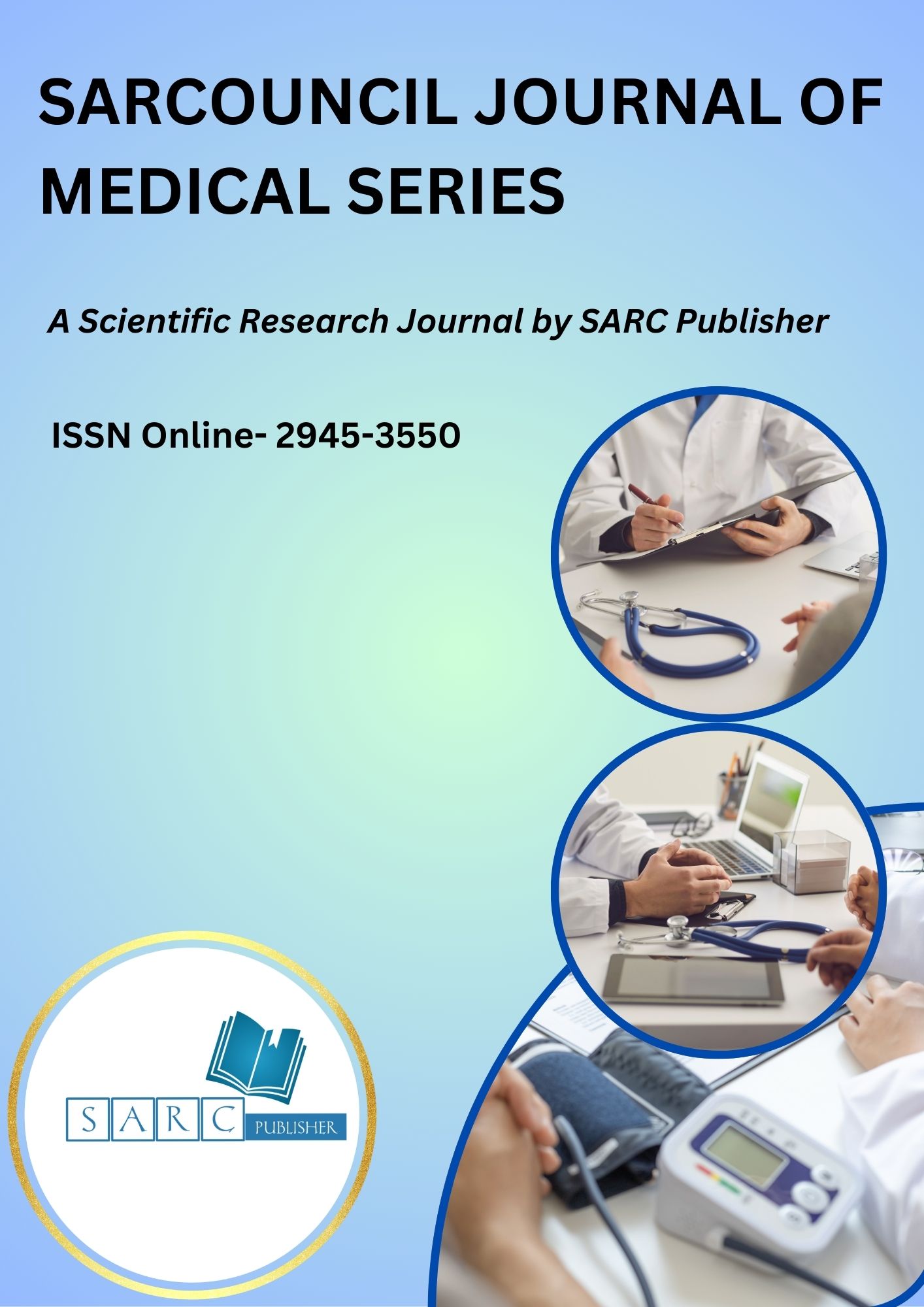Sarcouncil Journal of Medical Series

Sarcouncil Journal of Medical Series
An Open access peer reviewed international Journal
Publication Frequency- Monthly
Publisher Name-SARC Publisher
ISSN Online- 2945-3550
Country of origin- PHILIPPINES
Impact Factor- 3.7
Language- English
Keywords
- Pathology, Radiology, Serology, Surgery, Biochemistry, Biophysics, Cytology, Embryology, Endocrinology, Epidemiology, Genetics, Histology
Editors

Dr Hazim Abdul-Rahman
Associate Editor
Sarcouncil Journal of Applied Sciences

Entessar Al Jbawi
Associate Editor
Sarcouncil Journal of Multidisciplinary

Rishabh Rajesh Shanbhag
Associate Editor
Sarcouncil Journal of Engineering and Computer Sciences

Dr Md. Rezowan ur Rahman
Associate Editor
Sarcouncil Journal of Biomedical Sciences

Dr Ifeoma Christy
Associate Editor
Sarcouncil Journal of Entrepreneurship And Business Management
Diagnose SARS-CoV-2 Infection by PCR and Rule out Alternative Diagnoses if GBS is Associated with Impaired Consciousness
Keywords: Guillain Barre syndrome, nerve conduction studies, cerebrospinal fluid, SARS-CoV-2, COVID-19
Abstract: We read with interest Suci et al’s article about a patient with Guillain Barre syndrome (GBS), subtype acute, inflammatory, demyelinating polyneuropathy (AIDP), which occurred seven days after the diagnosis of a mild SARS-CoV-2 infection Suci, Y.D. The patient received intravenous immunoglobulins and fully recovered after three months or physical rehabilitation [Suci, Y.D. et al., 2023]. It was concluded that SARS-CoV-2 infections can manifest with various neurological symptoms and that autoimmune or cerebrovascular disease should be considered in a SARS-CoV-2 infected patient with acute, progressive muscle weakness [Suci, Y.D. et al., 2023]. The study is impressive but some points require discussion. The major limitation of the study is that the index patient did not undergo cerebrospinal fluid (CSF) examinations [Suci, Y.D. et al., 2023]. To meet diagnostic level A of the Brighton criteria for the diagnosis of GBS, it is critical that a patient undergoes a CSF examination. CSF typically shows a dissociation between elevated protein levels and normal cell counts. When there is uncertainty about the diagnosis, as in the index case, it is crucial to rule out infectious or immune encephalitis / meningitis by performing CSF examination. A second limitation is that the patient did not undergo MRI. Multimodal MRI is more sensitive than CT in diagnosing acute ischemic stroke or immune or infectious encephalitis. A third limitation of the study is that the cause of headache that occurred on the seventh day after the onset of the SARS-CoV-2 infection could not be fully clarified. Given that headaches in SARS-CoV-2 infected patients are multicausal, how can the authors be sure that it was tension-type headache? We should know whether infectious encephalitis / meningitis, immune encephalitis / meningitis, reversible cerebral vasoconstriction syndrome (RCVS), venous sinus thrombosis (VST), bleeding, and subarachnoid bleeding (SAB) were appropriately excluded in the index patient. A fourth limitation is that the patient was never tested positive for SARS-CoV-2 by PCR [Suci, Y.D. et al., 2023]. We should know how the index case was diagnosed with COVID-19. We disagree with the statement in the abstract that neurological involvement in SARS-CoV-2 infection is rare [Suci, Y.D. et al., 2023]. Neurological abnormalities are the most common extrapulmonary manifestations of SARS-CoV-2 infections. The most common neurological manifestations of SARS-CoV-2 infections include headache, dizziness, hypogeusia/ageusia, and hyposmia/anosmia [Finsterer, J, 2023]. Less common, cerebrovascular disease (ischemic stroke, intracerebral bleeding, subarachnoid bleeding), carotid artery dissection, RCVS), secondary infectious or immune encephalitis (limbic encephalitis, brainstem encephalitis, cerebellitis, transverse myelitis, hypophysitis), demyelinating central nervous system (CNS) disease (ADEM, AHNE, AHLE, ANE, MS, MOGAD, NMOSD), seizures, opsoclonus myoclonus syndrome, cerebral vasculitis, giant cell arteritis, single or multiple cranial nerve neuritis, GBS, plexitis, polyneuropathy, myasthenia, and rhabdomyolysis have been reported [Finsterer, J, 2023]. We also disagree with the statement that “electromyography showed GBS” [Suci, Y.D. et al., 2023]. The diagnosis GBS is based on clinical presentation, nerve conduction studies (NCSs), and CSF analysis. The diagnosis is supported by NCSs but not by electromyography. NCSs allow differentiation between axonal and demyelinating subtypes of GBS and can document which nerves are involved and to what extent. The patient was admitted with “reduced consciousness” [Suci, Y.D. et al., 2023]. We should know whether the patient was drowsy, soporous, or comatose. Knowing the extent of impaired consciousness is crucial in order to be able to assess whether the SARS-CoV-2 infection had CNS involvement or only involvement of the peripheral nervous system. Knowing the extent of the impaired consciousness is also critical because the patient has been intubated and ventilated and assessment of consciousness is no longer possible from this point on. The patient reported double vision [Suci, Y.D. et al., 2023]. However, double vision is a rare manifestation of GBS. Was the double vision due to impairment of cranial nerves III, IV, and VI or was there evidence of CNS involvement, including the brainstem? On clinical examination, there was no impairment of cranial nerves III, IV and VI and no double vision [Suci, Y.D. et al., 2023]. How can this discrepancy between the examination and the patient’s symptoms be explained? How is it possible that clinical neurological examination revealed “decreased movements of the upper and lower limbs” when the patient was intubated and presumably sedated, making voluntary movements impossible? Finally, the conclusion drawn are not supported by the reported results. In summary, the interesting study has limitations that put the results and their interpretation into perspective. Clarifying these weaknesses would strengthen the conclusions and could improve the study. For the diagnosis of SARS-CoV-2 related GBS, the Brighton diagnostic criteria should be met and various differential diagnoses should be excluded accordingly. In patients with impaired consciousness, it is imperative to rule out CNS disease using MRI. CSF tests are mandatory to diagnose GBS
Author
- Josef Finsterer
- MD; Neurology Dpt.; Neurology & Neurophysiology Center; Vienna Austria.

